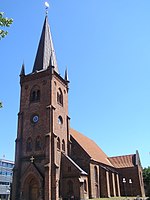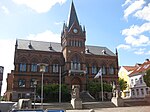Vejle Municipality

Vejle Municipality (Danish: Vejle Kommune) is a municipality (kommune) in the Region of Southern Denmark on the Jutland peninsula in southeast Denmark. The municipality covers an area of 1,058.43 km2 (408.66 sq mi) (2013), and has a population of 120,949 (1. January 2023). Its mayor is Arne Sigtenbjerggaard, a member of the liberal party Venstre. Vejle Municipality's offices are located in its largest population center, the city of Vejle. In its current configuration, Vejle Municipality was formed under the Municipal Reform of 2007 (Kommunalreformen) by merging the previously existing Vejle Municipality with the neighboring municipalities of Børkop, Egtved, Give (except for properties in two parishes Lindeballe and Ringive occupied by Billund Airport, which became part of Billund Municipality), Jelling, as well as the parish of Grejs, which formerly belonged to the municipality of Tørring-Uldum. The municipality is part of Triangle Region and of the East Jutland metropolitan area, which had a total population of 1.378 million in 2016.The central administration of the Region of Southern Denmark is in Vejle, located in the former Vejle County offices at Damhaven 12.
Excerpt from the Wikipedia article Vejle Municipality (License: CC BY-SA 3.0, Authors, Images).Vejle Municipality
Gammelhavn, Vejle
Geographical coordinates (GPS) Address Nearby Places Show on map
Geographical coordinates (GPS)
| Latitude | Longitude |
|---|---|
| N 55.705 ° | E 9.5328 ° |
Address
Gammelhavn
Gammelhavn
7100 Vejle
Region of Southern Denmark, Denmark
Open on Google Maps










